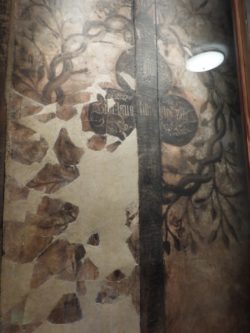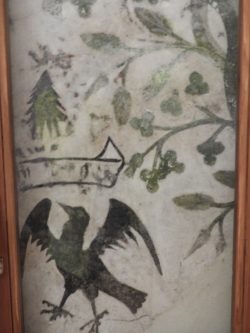IMC visit to Dominican Friary yields new insights
During the excursion to the historic East Yorkshire market town of Beverley, delegates helped local experts understand paintings found in the old Dominican Friary. Barbara English and Susan Neave take up the story...
As part of the IMC excursion to Beverley on Thursday 4 July 2019, participants visited the remains of the Dominican Friary, close to the Minster and down Friars’ Lane. The Dominicans had been on the site since c. 1240, and in the early 14th century there may have been 42 friars here. There are very few friary buildings left in Britain, as being in towns, their stone was quickly reused, and in many towns only the friars’ nicknames from their clothing, Blackfriars, Whitefriars and Greyfriars show where they once lived.

Fig. 1 The Trinity symbol with wreath and Trinitarian prayer. Photo by Colin Bradshaw.
It is perhaps because the Beverley Dominican Friary became the house of Michael Warton in the 1580s that it survived. He and his immensely rich son Sir Michael extended the existing building. The anomaly for historians has been that the two surviving Catholic wall-paintings are not on the medieval walls but within the brick post-Reformation western end of the range. The visit of the IMC scholars confirmed the local historians’ view that the paintings represented not the pre- Reformation faith, but the crypto -Catholicism of the early 17th century.
The largest wall painting (both are on east walls of a small ante-room) is a trefoil, symbol of the Trinity, surrounded by a wreath. The painting was partly destroyed in the 1960s by vandals, at a time when there was enormous pressure to demolish the Friary to allow the expansion of a factory, but enough remains to decipher most words (fig 1). The other painting is of intertwined branches, with black birds and ermine, and also short inscriptions which have been read either as Jesu Mercy or Ave Maria. Both of these can be associated with Catholic devotion (fig.2).
Two of the IMC scholars (David Bell and Antonio Petagine) recognised the words on the Trinity symbol as part of a prayer of Trinitarian friars, Tibi laus tibi gloria tibi gratiarum actio. In discussion It was agreed that it was improbable that the Dominicans would have used this Trinitarian prayer. This confirmed the assumption that the painting was post-Reformation, and in times when to practise Catholicism was dangerous, such paintings would be concealed from the world. In the late 16th century, the Wartons were Catholic sympathisers.

Fig. 2 Branches, birds, ermine and inscription (detail). Photo by Colin Bradshaw.
The birds on the smaller wall painting have sometimes been interpreted as blackbirds, for the black friars. But they are also the heraldic symbol of the East Riding Creyke family. Everilda née Creyke was an ardent Catholic – and married Sir Michael Warton in c.1620. Together the two paintings, perhaps of different ages (and certainly different styles) provided Catholic messages for recusant Wartons.
In the East Riding (of which Beverley is the principal town) many of the great families remained Catholic, the Constables of Burton Constable, the Constables of Everingham, the Ellerkers, the Wartons and others. Family members were heavily fined and sometimes imprisoned in York Castle, but still many refused to conform, as ‘recusants’. Some members of the families went to Anglican churches, to allow the family to survive, and some of the wives went to prison, being released after a time, only to return. One house in eastern Yorkshire, Carlton Towers, has a secret priest’s hole – the Beverley Friary has secret Catholic paintings. The IMC delegates have greatly helped to strengthen this identification.
Further Reading:
- Allison, Keith, VCH East Riding VI (1989)
- Cross, Claire, ‘Friars, the Pilgrimage of Grace, and the Dissolution of the Dominican and Franciscan Priories in Sixteenth-century Beverley’, Yorkshire Archaeological Journal XC (2018) pp 96-110
- Foreman, Martin, Beverley Friary (1998)
- Miller, Keith, Robinson, John, English, Barbara and Hall, Ivan, Beverley: an archaeological and architectural study (RCHM 1982)
- Pevsner, Nikolaus and Neave, David, York and the East Riding (1995)
The Friary is a Grade II* listed building, but the English Heritage listing does not mention the paintings.
With thanks to Jennifer Alexander, David Bell, Colin Bradshaw, Barbara English and Susan Neave.
